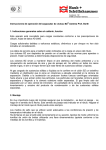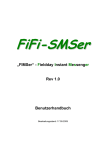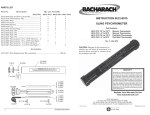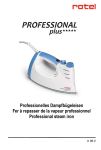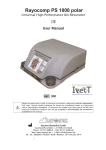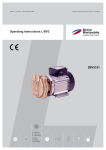Download Operating instructions BZ
Transcript
Hundemstr. 132 57368 Lennestadt / Germany Operating instructions for BZ cyclone separator® system Prof. Barth 1. General information on the pressure vessel, operation These vessels are designed for static load according to the calculation regulations of the AD 2000-Merkblätter instruction sheets. Additional forces due to static, dynamic or shock load were not taken into account. The specifications for the pressure vessel are indicated on the enclosed copy of the nameplate. BZ cyclone separators are pressure vessels as defined by the pressure vessel regulations or the pressure vessel directive. Therefore they are subject to certain safety requirements. BZ cyclone separators help to clean the air (protection of the environment) and to recycle substances from the exhaust air, exhaust fumes etc. They are used for all applications in which gas, air or steam must be free from solid or liquid components. In the BZ cyclone separator the gas loaded with solid or liquid components is given an angular momentum by a control device which makes it rotate with a high rotational speed in the separator. Due to the acceleration, strong centrifugal forces directed to the outside cat upon the particles. The particles are thrown against the separator wall, slide into the collector and are separated from the gas. The cleaned gas leaves the separator through a central submerged pipe. Shielding of the collector prevents the separated condensate or the separated solid material from being whirled up and swept along. 2. Assembly The system –must be assembled in the direction of arrow – i.e. according to the flow-through direction. The flow direction is indicated on the nameplate. After assembly, the nameplate must be clearly visible. The sealing materials used must comply with the pressure and temperature conditions indicated on the nameplate. The sealing must be installed properly. The flange connections must be tightened evenly. A torque spanner must be used. (Torque according to screw dimensions and material). 3. Start-up Prior to star-up, it has to be checked if the screws are tightened properly. Trouble-free discharge of the condensate must be provided for. The legal provisions of § 7 of the water management law in Germany have to be observed. Condensate discharge for the automatic HS float steam traps that are part of the delivery must be ensured. If possible, the system should not be started at maximum capacity. 4. Use/Operation BZ cyclone separators are more or less maintenance-free and work smoothly even with different volume quantities. It has to be made sure that the condensate is emptied regularly, depending on the condensate quantity. If automatic HS float condensate separators are installed, emptying is made automatically. When the condensate is emptied manually, an emptying interval must be defined, and emptying must be done regularly. Functioning of the BZ cyclone separator is not guaranteed if the condensate rises to high. 5. Maintenance / Inspection Once a year the separator has to be inspected visually, especially the welded seams. The screw connections must be checked with a torque spanner once a year. Separators from size 125 upwards have a block flange with lid in the lower bottom for inspection. The separator must be shut down and set at zero pressure. The inspection lid must be removed to enable visual inspection of the collector. It is recommended to use a mirror for the inspection. After the inspection the block flange has to be closed with the lid in accordance with the instructions. A new sealing has to be used every time. The screws must be tightened equally with the torque spanner according to the screw dimensions. Repeated pressure checks must be carried out according to the regulations of the national and international authorisation authorities. 6. Longer standstills If the separator is shut down for a longer period of time, the interior has to be cleaned with acids or sandblasting. The openings must be closed with metal lids and rubber sealings. In order to avoid damage due to corrosion, it is recommended to fill the interior with nitrogen (0.3 bar ü). Edition: august 2001 HAUB + SCHÖLLNHAMMER



